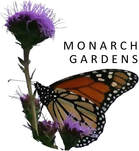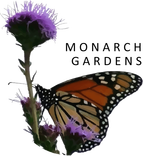I know people are super adverse to using glyphosate to prep an area for a native plant garden. Of course. I certainly don't love using the stuff, however, it has its benefits -- especially in the garden install world (time, efficacy), invasive weed control world, habitat restoration world. Anyway, I've discussed these points in detail on the blog and in the book -- including the fact that horticulture vinegar is more toxic, since I know some use it as a targeted weed killer. (NB: we don't use any product to weed in our gardens, it's all done by hand and by helping the good stuff out compete through various design and management methods.)
But the point I want to make today is about solarizing using plastic sheets to prep a site. We are, of course, all free to do as we choose and what fits our ideology and ability and timeframe and goals, but here are my thoughts on solarizing:
1) Solarizing fries soil life. And it does so over a long period of time. It sterilizes.
2) The best method to solarizing -- especially on a weedy site -- is to put plastic on for 4 weeks, take it off for two weeks to let weed seeds germinate, put it back on for 4 weeks to kill new weeds, take it off for two weeks, etc all through one entire growing season in order to exhaust the weed seed bank. I can guarantee you that if you do this in a suburban front yard you will face headwinds from neighbors -- and then again when, you know, you actually plant a garden and don't have lawn. Double trouble. And the larger the space you have to do (1,000-10,000 feet) the more problematic the entire, long process becomes.
3) All of the plastic sitting out in the sun for weeks and months is going to start breaking down. You may or may not notice -- fading, tearing, fraying, or nothing perceptible at all. In that process the plastic will likely release thousand and millions of little bits of microplastics we can't see, but it's there, just as it is from our washing clothes, walking on carpet, scraping a plastic food container with a fork, on and on. We have a MAJOR micro plastic problem and we don't fully understand what it's going to do to us. Those little bits will find their way into the ecosystem -- groundwater and air -- filtering and collecting up the trophic level from plants to insects to mice to birds and fish to people. That plastic will be around a heckuva lot longer, way way way longer than any residual from 1-2 applications of glyphosate, which breaks down in the soil quickly (of course, using it on a cornfield decade after decade DOES kill soil life and it then DOES runoff into streams etc because there's no soil life left to break it down).
There is no perfect solution to prepping a site for conversion to a meadow or other native plant garden. Again, I discuss the pros and cons of each in the book and on the website and in the online classes -- and have done so here before -- so won't reiterate in this small space. Do the ends justify the means, no matter what those means are? That's for all of us to carefully weigh.
I strongly believe it's important that we fully reconsider solarization, from the soil life being cooked to the microplastics to the obvious plastic waste of that sheet when you're done using it (do you just trash it, either now or a decade after sitting in the garage?). Hopefully, we can reflect on the complex issues without being angry or defensive, and if this post doesn't move the needle that's fine, too; this post exists to try and provide a more well-rounded response to the many posts I see regarding how awesome solarizing is, how benign it is, how green it is, and how natural it is. If anything, solarizing is as problematic as any other method, including renting a gas-powered sod cutter.
As always, if you comment please do so respectfully of one another. And I hope the above helps us think more critically, no matter what way we all ultimately decide to go in site prep. We're all in this together. Prairie up!


 RSS Feed
RSS Feed

